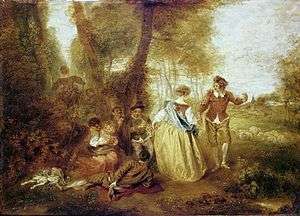Pastoral Pleasure
Pastoral Pleasure (French - Le Plaisir pastoral) is a c.1714–1716 fête galante painting by Jean Antoine Watteau, now in the musée Condé in Chantilly.[1] [2] Two other Watteau paintings survive with extremely similar compositions - the largest and most finished is The Shepherds (Schloss Charlottenburg), whilst another seems to be a reworking of the Charlottenburg painting (Wildenstein collection). Pierre Rosenberg argues that the Chantilly version was an oil sketch for the Charlottenburg work. Three other copies of the Chantilly version appeared in 19th and 20th century auctions, but their locations are now unknown.[3]
| Pastoral Pleasure | |
|---|---|
 | |
| Artist | Jean Antoine Watteau |
| Year | c.1714-1716 |
| Medium | oil on canvas |
| Dimensions | 31 cm × 44 cm (12 in × 17 in) |
| Location | Musée Condé, Chantilly |
The Chantilly work belonged to Pierre-Jean Mariette, a great Watteau collector – it is mentioned as being in his house from at least 1729, around which time Nicolas-Henri Tardieu made an engraving after it. On 1 February 1775 it was sold after Mariette's death. According to Edmond de Goncourt, it was resold in Paris on 11 May 1789, entering the marquis de Maison's collection, which was acquired in its entirety by the duc d'Aumale in 1868 whilst in exile in the United Kingdom. After moving back to France he hung the work in his château de Chantilly, where it still hangs in the musée Condé.[4]
Analysis
It shows French aristocrats dressed as shepherds – one couple dances to the right and a young couple court each other on a balcony to the left. The painting also includes real peasants in simpler clothes and with simpler gestures, making it easier to distinguish between them and the aristocrats than in other Watteau paintings such as The Shepherds.[5] Several details are directly inspired by Peter Paul Rubens's paintings: the musician, the man next to him, the shepherd embracing the woman next to him and the dog in the foreground.[6]
References
- "JOCONDE entry" (in French).
- "Museum catalogue entry" (in French). Archived from the original on 2016-03-11. Retrieved 2018-07-13.
- (in French and French) Nicole Garnier-Pelle, Chantilly, musée Condé. Peintures du xviiie siècle, Réunion des musées nationaux, coll. « Inventaire des collections publiques de France » (no 38), 1995, 222 p. (OCLC 300738204), p. 149-151 (notice 111).
- (in French) Nicole Garnier-Pelle, Chantilly, musée Condé. Peintures du xviiie siècle, Réunion des musées nationaux, coll. « Inventaire des collections publiques de France » (no 38), 1995, 222 p. (OCLC 300738204), p. 149 (notice 111).
- Amy Wyngaard, "Switching Codes: Class, Clothing, and Cultural Change in the Works of Marivaux and Watteau", Eighteenth-Century Studies, The Johns Hopkins University Press, vol. 33, no. 4, Summer 2000, p. 523-541
- (in French) Nicole Garnier-Pelle, Chantilly, musée Condé. Peintures du xviiie siècle, Réunion des musées nationaux, coll. « Inventaire des collections publiques de France » (no 38), 1995, 222 p. (OCLC 300738204), p. 151 (notice 111).
Further reading
- Camesasca, Ettore, ed. (1971). The Complete Painting of Watteau (loan required). Classics of the World's Great Art. Introduction by John Sutherland. New York: Harry N. Abrams. p. 113. ISBN 0810955253. OCLC 143069 – via the Internet Archive. Cat. no. 150.